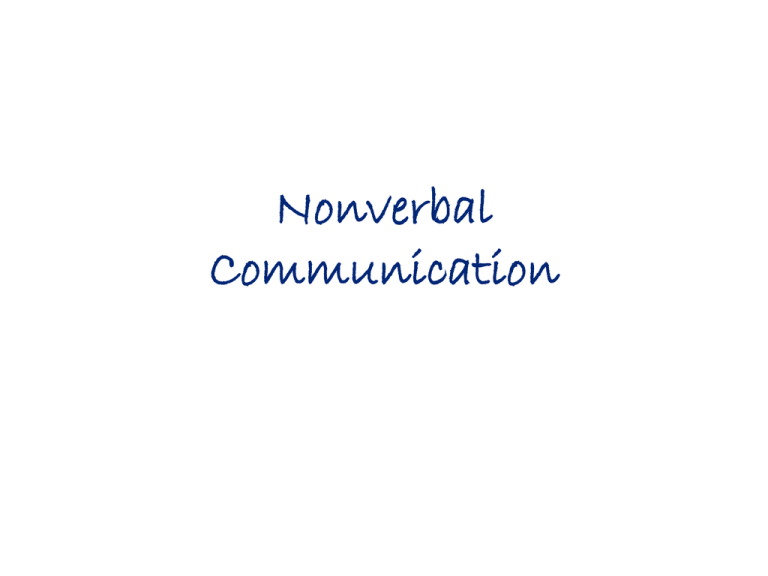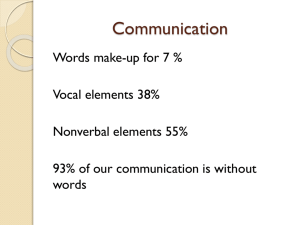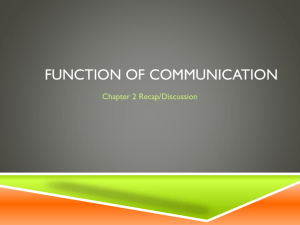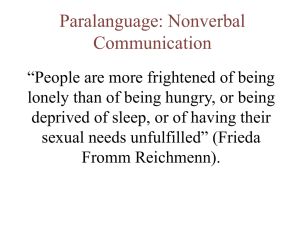NON VERBAL COMMUNICATION
advertisement

Nonverbal Communication Action Speaks Louder than Words!! ZIDANE He’s probably very angry. Nonverbal Communication • All kinds of human messages/responses expressed without using words • Expressed both consciously and unconsciously Types of Nonverbal Communication 1. Kinesics 2. Paralanguage 3.Proxemics 4. time language 5. Physical context Kinesics • Body language or kinesics: - Body Movement - Gestures - Posture - Facial Expressions - Eye Contact - body shape( ectomorph- thin and tall, endomorph, mesomorph “Communication depends heavily on the actions, postures, movements and expression of our bodies“ – by Desmond Morris(1979). • Walzlawick wrote: You can not not communicate. Be Aware About Your Body Language • In spite of your intelligence you may not get a job. • Even though you are not a best scorer, you may get a good job by your nonverbal behavior Before people started speaking languages. Gestures were the only medium of communication & of revealing one’s intensions Gestures may not be inborn as crying , shouting etc. Some gestures however are genetic; where as some are learnt and few are related to one’s culture Fear Anger Surprise Happiness Disgust Sadness Telling a Lie Attention Fear or Frustration Winning Face Eye Contact Eyes which can find out the behavior Eye is the window of the mind Maintaining good eye contact shows respect and interest in what they have to say. • Western cultures — see direct eye to eye contact as positive (advise children to look a person in the eyes). But within USA, African-Americans use more eye contact when talking and less when listening. • Nepal, Japan, Africa, Latin American, Caribbean avoid eye contact to show respect. Palm facing down indicates Telling some body to sit down or stopping some body Facing up position (gesture of submission) FACING DOWN POSITION (REQUEST WITH AUTHORITY ) Equality When a person rubs his palms together he is communicating something positive News of success Cheerful If a person Sits back , crosses her arms and legs, it is definite that her decision is negative Gripping arms around the body tightly indicates …the person is waiting for a call or anxious to know a thing that is unfamiliar Folding arms indicates the social status also Boss intends to speak to his juniors 2. Time language • The study of our use of time Ancient cultures have established their own system in measuring time which differs from one to another. • Example : Muslims use moon-based calendar system. The usage of time varies from culture to culture. • Example : Arabs engage in up to half an hour of informal conversation before turning to business. 3. Paralanguage(like language) Examples: Paralanguage include the • Loudness indicates strength following: in Arabic cultures, indicates - Vocal characterizers confidence and authority to such as laughter and the Germans and softness indicates weakness; sobs. it is opposite to Asian - Vocal qualifiers, such • But culture. Loudness indicates as intensity(loud/soft), impoliteness to the Nepalese/Thais indicates pitch (high/low), extent loss of control to the (clipping). Japanese. Generally, one - Vocal segregates, such learns not to “shout” in Asia for nearly any reason. as “Uh“, “Um“ and “ Uh• Gender based as well: women huh“. tend to speak higher and more softly than men. 4. Proxemics • The study of our use of personal distance is proxemics. • “Cultures differ substantially in their use of personal space” – Edward Hall (1959). Proxemics … Distance Description Private situation Intimate Touching to 18 with people who inches are emotionally Close. Personal 18 inches to 4 Handshake feet Distance. Social Public 4 to 12 feet 12 feet Voice whisper Soft voice Distance between customers and Full voice people. Teacher in a classroom. voice –. 5. Physical Context How color, lay out , design etc. communicate Color: it can project certain mood or feeling Black, grey- negative Blue, yellow- pleasant Lay out and design • Carpeting, arrangement of desk and bench, office size, design etc. communicate a lot. Pnyx • • • • Agora Nonverbal Issues and Misinterpretation Nonverbal communication is pervasive Nonverbal actions and their different meaning due to cultural differences. USA=OK RUSSIA=ZERO JAPAN=MONEY BRAZIL=INSULT Posture • Bowing (not done, criticized, or affected in US; shows rank in Japan) • Slouching (rude in most Northern European areas) • Hands in pocket (disrespectful in Turkey) • Sitting with legs crossed (offensive in Ghana, Turkey) • Showing soles of feet (Offensive in Thailand, Saudi Arabia) Touch • Touch is culturally determined and each culture has a clear concept of what parts of the body one may not touch. • In Western culture, handshake is common (even for strangers), hugs, kisses for those of opposite gender or of family (usually) on an increasingly more intimate basis. • Most Africans touch on greeting but are annoyed if touched on the head (good boy, good girl overtones). Touch … Islamic and Hindu: typically don’t touch with the left hand. To do so is a social insult. Left hand is for toilet functions. In Nepal, India/Bangladesh (some other Asian countries) to receive anything from others is only allowed with right hand. • Islamic cultures generally don’t approve of any touching between opposite-sex (even hand shakes). But consider such touching (including hand holding, hugs) between same sex to be appropriate. • Mind your body language. • Be an effective communicator.











